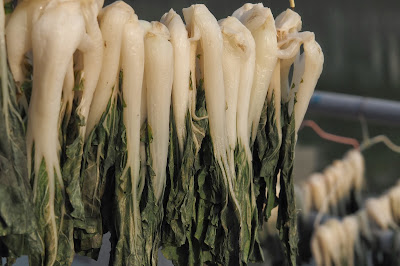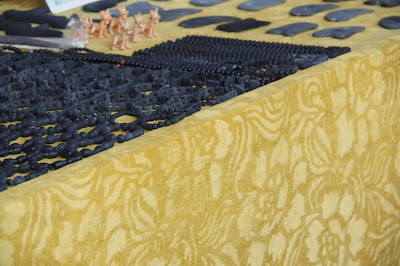(Cont'd)

This is a panoramic view of the two rows of houses copied from the Internet. There are a total of some 108 such houses more than half of which belonging to the biggest name there Boey (Mui). So they are popularly known as the Mui Family Court (梅家大院). They were all built in the 1940's just before WWII and reflected the Western architectural style of the period and is the site where the famous Chinese film "Let the Bullets Fly" was filmed. It's one of the best preserved kind of buildings of the period. A typical feature of such houses is that each of their verandahs are supported by front pillars on the kerbside facing the huge courtyard.
A plague showing that the group of buildings are now declared heritage buildings of "lately modern" overseas Chinese buildings.

On the ceiling immediately beneath the verandahs, each family have got their own peculiar Chinese style logos so that no two logos are the same
Another one of those logos
This one is more elaborate
This one is relatively simple
This one has a Chinese character right at its centre
The style of this logo is definitely more European
This used to be a grocery store
Another old fashioned shop with iron bars over its window: a Chinese style remittance house?
This one is probably a herbalist shop
This one used to be a Chinese medicine clinic
This small shop is still open for business for making advertisement light boxes
an advertisement sign for a long distance public telephone
A symmetrical design. Why the slipway-support in the middle of the steps? For bicycles?
Some of the houses are still inhabited but not many
Broken windows sealed up with planks? Emigrated? Living in nearby towns now?

Square and round pillars on the first floor verandahs.
It seems that yellow is a favourite color: Portuguese influence?
This one seems to have been renovated quite recently
complete with Chinese painting mural on the exterior parapets of its roof but its style seems so out of character with the older buildings adjoining it.
Agricultural machinery seems to be strewn around randomly on the pavement outside some of the houses.
or in the middle of the court
To while away the time, some of the local inhabitants put out a foldable table to sell various local farm produces: roots, beans, dried mandarin orange skins, salt fish, the famous local rice etc.
These are dried slices of a local root plant for making soup
These are the famous local "chicken feet yam"
peanuts laid out on trays for drying in the sun. A nice comfortable siesta spot for this dog.


What better than a game of "mahjong for health" to keep the brain working for the village folks.
Right behind the row of buildings is the local river
a sampan shelter
Nothing is ever wasted in rural China. A mop made with recycled materials.
Two paper chicken in front of a shop selling the famous "chicken baked in heated salt". As it was barely half an hour after lunch, not for me, I had to resist the temptation.
According to this advertisement, taking black sesame will help one resist the harmful radiation from our cell phones.
This old gentleman was draining the liquid rice pulp from his stone mill
His daughter gave him a hand. They were so friendly. I ordered a "black
seasame soup" as a dessert. Simply delicious! And just RMB5! Where else
could you get such quality in Hong Kong. Not even at 6 times the price!
Our next stop was an old town called Chik Ham (赤坎) or Red Hollow, a small town of some 5 square km with less than 50,000 people but with descendants in Hong Kong, Macau, Taiwan and elsewhere of 72,000. According to this plaque, this riverside town had a history of some 350 years and was largely built by two big extended families the Szetos (司徒) on the east bank and the Kwans (關) on the west bank of the river. The Szetos originally came from 邯鄲 in Hopei Province and moved south during the time when the 金 armies invaded their homeland and it was their 7th head of clan 司徒新唐 (1324-1392) who relocated their clan here. The Kwans moved here much earlier from Fujian and according to their clan chronicles, their 6th generation head of clan 關興義 first moved to San Hui in 974 because he didn't fare well as a government official and then their 6th generation moved here slightly later. The two clans never got along. It was the Szeto who first started the town fair every 3rd and 8th day of the lunar calendar. That's why there's still a market place here called the "3.8 Fair". But the Kwans would hold their own town fair, one on each side of the river and the two clans often came to blows fighting for territory and influence.
At one time, it was a bustling little town which thrived on local river trade with a pier on its bank as far back as 1676 and it used was the seat of the county government of Hoi Ping County, now relocated to Sam Fou (三埠鎮). It was originally a part of Sun Hui County but with the development of land transport, it had lost its original function. Together with 周庄, 烏鎮, 朱山. 黃姚, it's the "fifth oldest small town" in China and one of the towns whose overseas descendants outnumber the locals.
The row of mixed East-West style houses on the West Bank Road. There are some 600 mixed East-Western style fortress-houses along a
3-mile stretch of road on the west bank of the river in this old town
characterized by their pillar-supported verandahs and roof decorations
A closer view of some of the buildings
The river
The locals made good use of the sun to dry their fish
All kinds of fish not sold were turned into salt fish
A splinter between the two split interior of the fish is as good as anything as a strut!
"White vegetable" too were also being dried at the railing on the riverbank
And preserved pork
Reed basket for sunning rice and vegetables or fish
A favorite local snack is "salt-baked eggs". This woman is seen preparing them on a wood-fire stove at the roadside
A stand advertising for sale of a specialty of Hoi Ping county: preserved bean curd.
bottled preserved bean curds, dried mandarin orange peels treated with snake gall and peanuts, bean paste, preserved gingers for sale on the West Bank Road (堤西路)
This lady was preparing bean curd pancake, lotus root pancake and fried green pepper stuffed with fish paste on her huge flat pan over a stove at the road side
This is the famous "salt-baked eggs"--from big to small, from chicken to goose!
This is the famous "salt-baked eggs"--from big to small, from chicken to goose!
This gentleman was enjoying a puff of water-filtered smoke with a bamboo pipe. As it was cold, he wore a cotton shirt under his T-shirt!
This stall sells Chinese calligraphy and Chinese painting on stones and bowls
"Keep Safe Beans" Key chains made with the shells of a local fruit, RMB10 a piece
Old pamphlets about early HK TV programmes and a Chinese martial arts cartoon.
Black Buddha beads
All kinds of nuts, peanuts, dried "Arahan fruit" for sale
peanut candy in the making. RMB5 a packet! Crispy and yummy!
Honey and local fruit wine
a close up on what's on offer
I wandered into a side street
This is what I found. To the ordinary folks, "public space" probably means "common property" in the PRC. Some "white vegetables" being dried right in the street!
a woman taking her wares to the market for sale
Plants have taken over the roof
Rooster on a makeshift cage right in front of a house on the roadside, very different from those we found at Floating Moon Village

Nothing is wasted!


Nothing is wasted!

Here, take this!
Run down houses
The style is probably pre-war, perhaps 1930's and 1940s. .
Plants and man
Withered plants on the roof
Not very many old shops are open for business
An old man puzzled by the incomprehensible antics of the cameraman
The streets look deserted
But this lady from the north seems to be working hard
Not a soul in this street either
A sign that it's not yet a ghost town
This family appear to likes color
More colors
What, an abandoned old cinema hall! I bet Clark Gable and Greta Gabo once appeared there!
I wandered to the "3.8" market
steamed yams!
Salt fish
Fresh river fish
What are you looking at? Some fish for you, Sir??? Real Fresh and cheap too!

More fish for sale
Not much different from India, except more varieties!
Ah yummy!
"9th Brother" Restaurant! Time for dinner! Not yet. Got to wait for the sunset.
The streets look deserted
But this lady from the north seems to be working hard
A sign that it's not yet a ghost town
This family appear to likes color
More colors
What, an abandoned old cinema hall! I bet Clark Gable and Greta Gabo once appeared there!
I wandered to the "3.8" market
steamed yams!
Salt fish
Fresh river fish
What are you looking at? Some fish for you, Sir??? Real Fresh and cheap too!

More fish for sale
Not much different from India, except more varieties!
Ah yummy!
"9th Brother" Restaurant! Time for dinner! Not yet. Got to wait for the sunset.
This the the library of the Kwans. Although it's a small town, there are
two public libraries. The other is built by the Szetos, who started the
first one and placed therein a special room about the history of their
family in the town. They started work in 1923 and completed it 2 years
later. Then the Kwans followed suit and completed theirs in 1929! The
two libraries are now still in use partly for clan meetings and the rest
as a public library. The Italians don't have an exclusive on family
feuds!
Another view of the library (from the internet)
The library of the Szetos (from the internet)
We were told by our local guide that the reason why she chose this town was to let us have a chance to photograph its sunset.
I did not want to waste her good intentions.
Another one
The river looks so peaceful
My final look at the sun
(To be cont'd)


























































































Hi thanks for the useful information you provided us with your blogs regarding sex dolls and big breast toys ,big breast toywe also have vital information that can pay meaningful contribution regarding the above mentioned subject,big breast masturbatorwe have different types of dolls available ,lina sexy dollfor more details ,sex doll mikasacontact us via the following listed details below.
回覆刪除call/text...+1(505)257-5355
email....support@hottiesexdolls.com